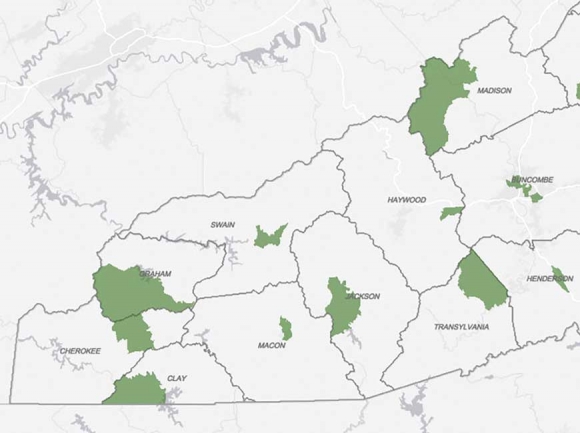‘Opportunity zone’ could bring business to poor areas
 Every county in Western North Carolina has at least one opportunity zone. N.C. Department of Commerce photo
Every county in Western North Carolina has at least one opportunity zone. N.C. Department of Commerce photo
When President Donald Trump signed the Tax Cuts and Jobs Act into law on Dec. 22, 2017, proponents hailed it as the most significant tax reform in three decades. Lost in the hullabaloo over the tiny, temporary tax bracket adjustments — financed by a burgeoning federal deficit — was a new program designed to spur investment in low-income census tracts across the country.
Halfway through the 186-page act is a section on the Opportunity Zones program, which allows a state to designate no more than 25 percent of its low-income census tracts as “opportunity zones.”
To qualify, tracts must have a poverty rate is greater than 20 percent, and/or a median family income less than 80 percent of median income in the area.
The North Carolina Department of Commerce reviewed data, gathered public input, talked to local officials and, according to the UNC School of Government, learned that 46 percent of all 2,195 census tracts in North Carolina would qualify.
With more than a thousand qualifying tracts, selecting the final 250 or so for certification by the U.S. Department of the Treasury was carried out with an eye on geographic distribution — 98 of 100 counties in North Carolina have at least one opportunity zone, and almost 40 percent of them are in census-designated rural areas, like Haywood County.
“I know the county submitted seven applications, and only one was selected,” said CeCe Hipps, Haywood Chamber president.
Related Items
That tract is number 9203, which starts in the heart of Canton and sprawls to the southeast, south of U.S. 19-23 to the Buncombe County line. Transylvania County’s zone abuts southeast Haywood County, down towards Pisgah Forest and backing up to the outskirts of Mills River.
Macon County’s tract is west of U.S. 23 and encompasses much of Franklin. Swain County’s is north of U.S. 19 between Bryson City and Whittier, and Jackson County’s tract starts just south of Webster and runs south, mostly west of N.C. 107 down past Tuckasegee to Thorpe Lake.
“It has the potential to be a good tool. We’ve had quite a bit of interest from developers touching base,” said Rich Price, Jackson County’s economic development director. “It includes a lot of the vicinity around WCU. We would imagine it could be beneficial for housing.”
Investors in any of these opportunity zones can realize a number of economic incentives designed not just to encourage development, but also to encourage long-term development by changing the way capital gains are taxed.
“We have had some interest because of this opportunity zone,” said Hipps, who added that some companies are looking only to locate in such a zone because of the capital gains benefits.

Haywood County’s opportunity zone includes part of Canton. N.C. Department of Commerce photo
A “capital gain” is the increase in value of a capital investment over the purchase price. Capital gains can be either short term — less than a year — or long term but either way, once the asset is sold that gain is subject to federal taxation sometimes approaching 30 percent.
The first benefit is that if taxpayers use existing capital gains to invest in an opportunity zone, those capital gains can be temporarily removed from their taxable income.
So, if the Acme Widget Company bought an asset, say, a piece of land, for $1,000 and then sold it for $2,000 a few years later, that $1,000 gain could be used to invest in an opportunity zone, instead of being whittled away through taxation.
The second benefit is what’s called “stepping up the basis.” If Acme Widget buys a piece of land in an opportunity zone for $1,000, then holds it for at least five years before selling it for $2,000, tax incentives allow Acme to add a 10 percent increase to the basis (the base price), meaning its taxable capital gain is only $900, instead of $1,000.
Using that same example, if Acme held the property for seven years instead of five, Acme could then add an additional 5 percent to that 10 percent basis increase, meaning it would only accrue $850 in taxable capital gains, rather than $1,000.
If Acme holds the property for 10 years, it will then be permanently excused from paying taxes on all capital gains accrued after investing in the zone, thus encouraging investors to take advantage of the maximum impact of the capital gains tax breaks by planning a long-term presence in the zone.
Going back to Acme Widget Company, if Acme realized a capital gain of $1,000 on the sale of some asset last year, taxable at 25 percent, it could simply pay the taxes on the gain and retain a cool $750.
If Acme instead invested that $1,000 in an opportunity zone this year, it wouldn’t have to pay any taxes at all on the $1,000 right now, and 10 years from now after an average appreciation of 7 percent, that $1,000 investment would be worth at least $1,967 but subject to a capital gains tax rate of exactly zero percent.
“People that are researching and looking for an opportunity zone see that we have one, and it brings additional folks our way,” said Hipps.









